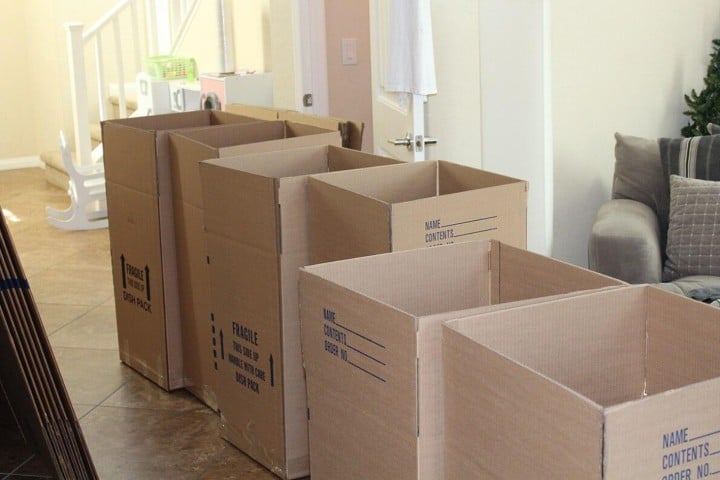For generations, cardboard boxes have reigned supreme in the realm of relocation. They’re readily available, relatively inexpensive, and protect our belongings during a move. However, cardboard has its limitations. It’s different from the epitome of eco-friendliness, as its production requires resources and its disposal contributes to landfill waste. Additionally, cardboard can become flimsy and prone to tearing under the weight of heavier items, especially during long-distance moves.
Thankfully, the moving industry is embracing innovation, offering a plethora of alternative box materials that are good for the environment and boast superior functionality. This guide delves into the world beyond cardboard, exploring the various options available and highlighting the benefits they bring to your moving experience.

A. Reusable Plastic Bins and Totes
These sturdy champions are the undisputed heavyweights regarding alternative moving solutions. Constructed from durable plastic, these bins and totes are built to withstand the rigors of relocation.
- Advantages:
- Durability: They can handle the weight of even the bulkiest belongings without succumbing to tears or collapsing.
- Weather Resistance: Rain or shine, your possessions remain safe from the elements.
- Stackable Design: Maximize storage space by stacking them neatly, creating an organized and efficient moving process.
- Reusable: A one-time investment that pays off in the long run. You can use them for storage after the move or for future relocations.
- Disadvantages:
- Cost: The initial purchase price can be higher compared to cardboard boxes.
- Weight Limitations: While highly durable, some plastic bins might have weight restrictions, so be sure to check the manufacturer’s specifications.
B. Biodegradable Packing Materials
Moving doesn’t have to come at the expense of the environment. Biodegradable packing materials offer a sustainable alternative to traditional packing peanuts and bubble wrap.
- 1. Packing Peanuts (e.g., corn-starch based):
- Benefits: These packing peanuts decompose naturally from plant-based materials like corn starch, minimizing environmental impact. They also provide excellent cushioning for fragile items.
- Drawbacks: They can be messy and might only be suitable for some items, especially those prone to dust or static.
- 2. Bubble Wrap (e.g., plant-based):
- Pros: This eco-friendly alternative to traditional bubble wrap is lightweight and protects your belongings well. Additionally, the plant-based material makes it a more sustainable choice.
- Cons: While reusable to some extent, it might not be as durable as its petroleum-based counterpart. The cost can also be slightly higher than traditional bubble wrap.
C. Fabric Moving Bags
Embrace reusability and eco-friendliness with fabric moving bags. These versatile bags are a great option for a variety of items.
- Upsides:
- Reusable: Eliminate the need for disposable cardboard boxes and contribute to a more sustainable moving experience.
- Eco-Friendly: Made from fabric materials like cotton or canvas, they have a minimal environmental footprint.
- Lightweight: Easy to carry and maneuver, especially helpful for those handling the move.
- Handles Heavy Items: Remember their strength. Some fabric bags are designed to hold significant weight, making them suitable for books, clothes, and other heavy belongings.
- Downsides:
- Packing Considerations: They may require more careful packing than boxes for fragile items to ensure proper protection.
- Not Ideal for All Items: Liquids, sharp objects, or oddly shaped items might not be suitable for fabric bags.
D. Furniture Covers
Furniture is often the most vulnerable element during a move. Furniture covers offer a layer of protection against scratches, dents, and dust while in transit.
- Plusses:
- Protect Furniture: These specially designed covers to safeguard your furniture from nicks and dings during transport.
- Reusable: Just like reusable bins and bags, furniture covers can be used for future moves or storage purposes.
- Minuses:
- Limited Use: Primarily for furniture protection, they aren’t a replacement for boxes for other belongings.
Benefits of Using Alternative Moving Box Materials
Moving beyond cardboard boxes offers many advantages, not just for the environment but also for your relocation experience.
A. Environmental Sustainability
You’re actively contributing to a more sustainable moving process by choosing alternative materials. Here’s how:
Reduced Reliance on Cardboard Production: Cardboard production requires resources and energy.
- Opting for reusable or biodegradable alternatives reduces the demand for cardboard production, which in turn helps conserve resources and minimize environmental impact.
- Biodegradable Materials Minimize Waste: Unlike traditional packing peanuts and bubble wrap, biodegradable options decompose naturally, leaving no harmful residues behind. This significantly reduces landfill waste associated with moving.
B. Durability and Protection
Moving doesn’t have to mean sacrificing the safety of your belongings. Alternative materials offer superior protection compared to cardboard:
- Reusable Options Offer Long-lasting Use: Plastic bins and totes can withstand multiple moves, unlike cardboard boxes, that can become damaged during the process.
- Superior Cushioning: Biodegradable packing peanuts and some fabric bags provide excellent cushioning for fragile items, minimizing the risk of breakage during transport.
C. Cost-Effectiveness (for some options)
While the initial cost of some alternatives might be higher, they can be more economical in the long run:
- Reusable Bins and Totes Save Money: The initial investment in reusable bins and totes pays off over time compared to repeatedly buying new cardboard boxes for each move.
- Reduced Need for Additional Packing Materials: Durable bins and some fabric bags might eliminate the need for additional packing materials like packing tape or extra bubble wrap, leading to overall cost savings.
Choosing the Right Alternative
With a variety of options available, selecting a suitable alternative moving box material depends on several factors:
- Type of Belongings: Fragile items require more protection compared to sturdy ones. Consider bubble wrap or fabric bags for delicate items and plastic bins for heavy objects.
- Distance and Mode of Transport: For longer distances or bumpy rides, prioritize sturdier materials like plastic bins or heavy-duty fabric bags. Cardboard boxes might suffice for shorter local moves.
- Budgetary Constraints: Reusable bins and totes offer cost savings in the long run, but their initial purchase price might be higher. Consider your budget and moving frequency when making a decision.
- Personal Preference: Do you prioritize reusability or disposability? Reusable options are eco-friendly but require more storage space. Disposable, biodegradable materials contribute less waste but might need to be more cost-effective.
Conclusion
Moving doesn’t have to be a burden on the environment or your wallet. Venturing beyond cardboard boxes and embracing alternative moving equipment can create a more sustainable and efficient moving experience. With various options available, choose the materials that best suit your needs and contribute to a greener future, one move at a time. The moving industry constantly evolves, with new and innovative sustainable solutions always emerging. As these advancements continue, eco-conscious moving practices become more accessible and convenient. So, the next time you relocate, consider exploring the exciting world beyond cardboard and embrace a good move for you and the planet.
We hope you found this blog post on Beyond Cardboard: Alternative Moving Box Materials And Their Benefits, useful. Be sure to check out our post on Ways Reusing Cardboard Moving Boxes for more great tips!
Have Experience in the Moving Industry? Want an Additional Income Stream? Work With All Around Moving!
Join our program! Put your experience in the moving industry and drive to good use. Profit as a moving consultant. Click here to learn more.





